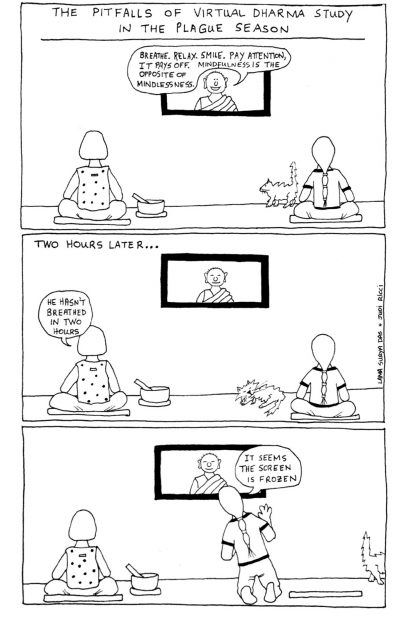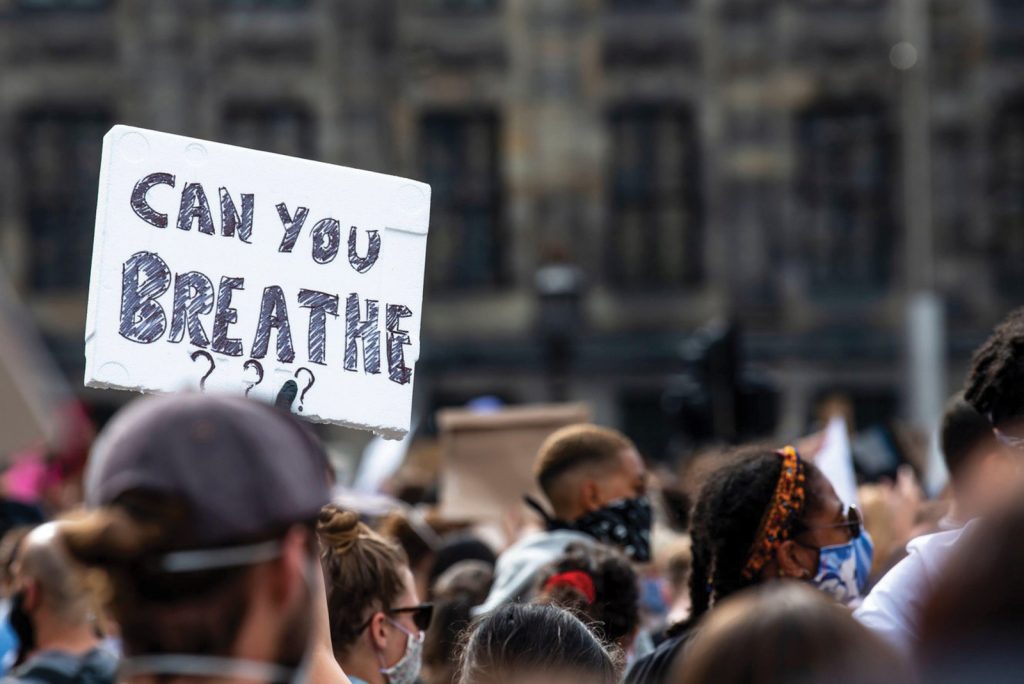In late May, protestors began pouring into the streets to demand an end to the long and disturbing history of police violence against people of color, which had recently claimed more lives, including that of George Floyd, whose public killing was captured on video. Tricycle responded to these demonstrations with a mix of new articles and essays from our archive exploring how the dharma can help us combat racism and see how the injustices of the broader society have played out in Buddhist communities.
In “Racial Justice Is Everyone’s Work,” we invited readers to revisit the works of Buddhist thinkers such as feminist scholar bell hooks, law professor and mindfulness instructor Rhonda Magee, and Buddhist studies professor Jan Willis. In “I Am Racist, I Vow to End Racism,” Tricycle’s senior editor, Matthew Abrahams, reflected on his own racist inclinations and invited other white Buddhists to do the same. “Racists like me have the privilege of forgetting about racism,” he wrote, stressing the importance of seeing one’s own privilege and practicing compassion for members of marginalized groups whose suffering one may not yet fully understand.
Many found the articles helpful. One reader, AJ, said it was reassuring to know that practitioners and writers of color “are able to express their voices and shine a light on racial injustice in the West … and this should not be overlooked or taken for granted, despite the all-loving and compassionate teachings within Buddhism.” But some found the posts insulting or thought concerns about racism represented dualistic thinking. Gary Dean wrote: “It’s sad, and even a little offensive, that poisonous American identity politics are given outlets and legitimacy.” Tricycle has long maintained that spiritual practice is not separate from the issues of our time and that Buddhist teachings about ending suffering include the suffering that results from political and social realities such as racial injustice. Yet, as Kelly Gurnett remarked, “It’s always amazing how a call to compassion pisses people off.”
Some readers agreed that Buddhist ethics do not support racism but objected to the suggestion that Western Buddhist groups are racist. In response to a Facebook post of the article “Brown Body, White Sangha,” in which Atia Sattar describes the experience of being a person of color at predominantly white Buddhist centers, reader Daniel Davis defended the sanghas. “They are more often than not a product of their locations and demographics,” he wrote from Thailand. But Buddhist organizations are not separate from their society and thus share responsibility for systemic injustice, as Andrew Cooper, Tricycle’s Features Editor, suggested in 1993 (“Starting Points,” first published in Turning Wheel). Cooper wrote that “to forget this historical dimension is to be shaped by it” and to perpetuate the culture’s “unconscious ideology.”

Readers also had mixed responses to Tricycle contributing editor Curtis White’s article “Our World in the Wheel of Life,” in which he critiqued modern American society and politics through the lens of Buddhist cosmology. Diane L. Meyer found White’s comparisons of contemporary figures to Buddhism’s six realms of existence—gods, demigods, humans, animals, hungry ghosts, and hell-dwellers—to be a helpful way to understand the “current miasma.” Others, however, took issue with the article’s explicit political engagement. The article “represents an egregious dereliction of editorial responsibility,” Michael Stallings commented. “I happen to share the opinions of the writer about most things, but the pages of a magazine supposedly devoted to the dharma is not the place for a political screed. It was especially offensive that such unskillful words were associated with a sacred image.” Mary Wilson echoed Stallings’s reaction: “I find this article extremely disturbing, and not what I expect from Tricycle,” she wrote, suggesting that categorizing people into nonhuman realms according to political stance contradicted Buddhist teachings. “I found no respect or compassion for the suffering beings with whom we all, including the author, inter-exist,” she said.
In “The Authenticity Trap,” the scholar of Buddhism Jay Garfield warned readers of the risks in striving to affirm one’s own form of Buddhism as the most “real,” or authentic, in contrast to others. In a comment online, Kenneth Daly recommended that readers of Jay Garfield’s article also return to Buddhist teacher and scholar Rita Gross’s 2011 Dharma Talk series “Buddhist History for Buddhist Practitioners” to understand how Buddhism itself is subject to impermanence. Such understanding, Gross insisted and Daly echoed, can enrich one’s own dharma practice.
Other readers, however, found Garfield’s article deeply problematic, even a “disservice to the dharma,” as Walt Kaimon Lyons put it.“The last thing that we need,” Lyons wrote, “is someone telling us that two thousand five hundred years of teaching is fake and that we can do anything that we feel like doing and call it Buddhism.” Lyons concluded with a call to action: “Let’s stop talking about authenticity and get ourselves to the cushion. Let’s stop talking about the practice and start doing it with vigorous effort and full commitment.”

The Question
Do you attend sangha meetings in person or online?
Online 100 percent now. I dig it. –Katrina Walling
I’ve been attending some online sanghas during the lockdown. I usually just meditate alone, so I’m enjoying the sense of community. –Mike Sturman
My sangha has been meeting three times a week virtually, and we’ve found that more members show up than they do at the gompa [temple] in person. Gathering together from home has been a bright light during this time! –Jane Lyon
Online. I was lucky enough to be invited to a group that I would have a hard time attending in person. Not impossible, though. I hope I can visit sometime when this crisis is over. –Sabina Sez
I just did a home retreat put together by Jack Kornfield, Tara Brach, and Trudy Goodman. I really loved it, but I miss the connection that you have when you attend sangha meetings in person. –Ilone Inge
At the moment, online. It has pros and cons. If it’s a meeting with our lama, it feels great to see him but not so great to not be in his presence. I also teach basic meditation, and online one-on-one sessions have worked wonderfully. –Alejandro Serrano
For the next issue:
What’s your favorite dharma movie?
Email your brief responses to editorial@tricycle.org, post a comment on tricycle.org, or tweet us at @tricyclemag.
Thank you for subscribing to Tricycle! As a nonprofit, we depend on readers like you to keep Buddhist teachings and practices widely available.
